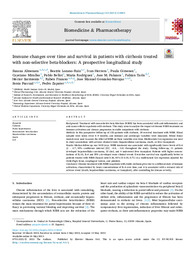Título :
Immune changes over time and survival in patients with cirrhosis treated with non-selective beta-blockers: A prospective longitudinal study |
Autor :
Almenara, Susana
Lozano-Ruiz, Beatriz 
Herrera, Ivan
Gimenez, Paula
Miralles Macia, Cayetano Fabian 
BELLOT, PABLO 
Rodriguez, Maria
Palazón, José M. 
Tarín, Fabián
Sarmiento, Héctor
Francés, Rubén 
González-Navajas, Jose Manuel 
Pascual, Sonia 
Zapater, Pedro  |
Editor :
Elsevier |
Departamento:
Departamentos de la UMH::Medicina Clínica
Departamentos de la UMH::Farmacología, Pediatría y Química Orgánica |
Fecha de publicación:
2023-07 |
URI :
https://hdl.handle.net/11000/35421 |
Resumen :
Background: Treatment with non-selective beta-blockers (NSBB) has been associated with anti-inflammatory and anti-cancer effects in patients with cirrhosis. This study aims to analyze the impact of chronic NSBB treatment on immune activation and disease progression in stable outpatients with cirrhosis.
Methods: In this prospective follow-up of 150 patients with cirrhosis, 39 received treatment with NSBB. Blood samples were taken every 6-9 months, and immune and adrenergic variables were measured. Mixed linear models were used to assess the effect of NSBB on these variables over time. Multivariate Cox regression was used to study associations with adverse clinical events (hepatocellular carcinoma, death, or liver transplant).
Results: Median follow-up was 1635 days. NSBB treatment was associated with significantly lower levels of IL-6 (β - 4.7; 95% confidence interval [CI] -6.9, -2.6) throughout the study. During follow-up, 11 patients developed hepatocellular carcinoma, 32 died, and 4 underwent liver transplant. Patients with higher concentrations of IL-10, IL-6 and IFN-γ developed more clinical events. Event-free survival was significantly better in patients treated with NSBB (hazard ratio 0.36, 95% CI 0.18, 0.71) in a multivariate Cox regression adjusted for Child-Pugh-Score, esophageal varices, and platelets.
Conclusion: Chronic treatment with NSBB in patients with stable cirrhosis gives rise to a different state of immune activation, characterized by lower concentrations of IL-6 over time, and it is associated with a reduced risk of adverse event (death, hepatocellular carcinoma, or transplant), after controlling for disease severity.
|
Palabras clave/Materias:
Cirrhosis
Portal hypertension
Non-selective beta-blockers
Hepatocellular carcinoma
Death
IL-6 |
Tipo de documento :
info:eu-repo/semantics/article |
Derechos de acceso:
info:eu-repo/semantics/openAccess |
DOI :
https://doi.org/10.1016/j.biopha.2023.114885 |
Publicado en:
Biomedicine and Pharmacotherapy. 2023 Jul:163:114885 |
Aparece en las colecciones:
Artículos Farmacología, Pediatría y Química Orgánica
|

 La licencia se describe como: Atribución-NonComercial-NoDerivada 4.0 Internacional.
La licencia se describe como: Atribución-NonComercial-NoDerivada 4.0 Internacional.
.png)